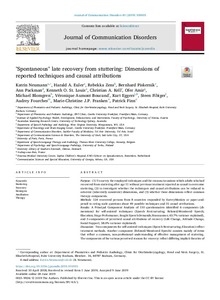"Spontaneous" late recovery from stuttering: Dimensions of reported techniques and causal attributions
Katrin Neumann; Harald A. Euler; Rebekka Zens; Bernhar Piskernik; Ann Packman; Kenneth O. St. Louis; Christian A. Kell; Ofer Amir; Michael Blomgren; Véronique Aumont Boucand; Kurt Eggers; Steen Fibiger; Audrey Fourches; Marie-Christine J.P. Franken; Patrick Finn
https://urn.fi/URN:NBN:fi-fe2021042821646
Tiivistelmä
Purpose: (1) To survey the employed techniques and the reasons/occasions which adults who had recovered from stuttering after age 11 without previous treatment reported as causal to overcome stuttering, (2) to investigate whether the techniques and causal attributions can be reduced to coherent (inherently consistent) dimensions, and (3) whether these dimensions reflect common therapy components.
Methods: 124 recovered persons from 8 countries responded by SurveyMonkey or paper-and-pencil to rating scale questions about 49 possible techniques and 15 causal attributions.
Results: A Principal Component Analysis of 110 questionnaires identified 6 components (dimensions) for self-assisted techniques (Speech Restructuring; Relaxed/Monitored Speech; Elocution; Stage Performance; Sought Speech Demands; Reassurance; 63.7% variance explained), and 3 components of perceived causal attributions of recovery (Life Change, Attitude Change, Social Support; 58.0% variance explained).
Discussion: Two components for self-assisted techniques (Speech Restructuring; Elocution) reflect treatment methods. Another component (Relaxed/Monitored Speech) consists mainly of items that reflect a common, non-professional understanding of effective management of stuttering. The components of the various perceived reasons for recovery reflect differing implicit theories of causes for recovery from stuttering. These theories are considered susceptible to various biases. This identification of components of reported techniques and of causal attributions is novel compared to previous studies who just list techniques and attributions.
Conclusion: The identified dimensions of self-assisted techniques and causal attributions to reduce stuttering as extracted from self-reports of a large, international sample of recovered formerly stuttering adults may guide the application of behavioral stuttering therapies.
Kokoelmat
- Rinnakkaistallenteet [27094]
